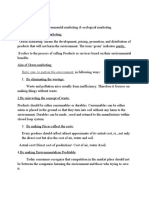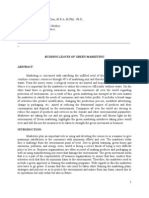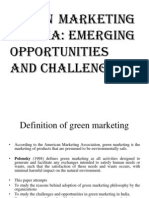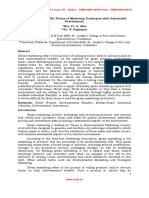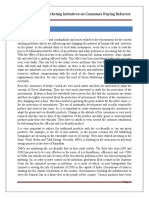CCCCCCCCCCCCCCCCCCCCCCC C C C
CCCCCCCCCCCCCCCCCCCCCCC C C C
Uploaded by
Aariful IslamCopyright:
Available Formats
CCCCCCCCCCCCCCCCCCCCCCC C C C
CCCCCCCCCCCCCCCCCCCCCCC C C C
Uploaded by
Aariful IslamOriginal Title
Copyright
Available Formats
Share this document
Did you find this document useful?
Is this content inappropriate?
Copyright:
Available Formats
CCCCCCCCCCCCCCCCCCCCCCC C C C
CCCCCCCCCCCCCCCCCCCCCCC C C C
Uploaded by
Aariful IslamCopyright:
Available Formats
CONTENT
Preface
Abstract
Tuble of content
1. Introduction ............................................................................................................................ 1
1.1 Buckground ...................................................................................................................... 1
1.2 Problem dlscusslon ........................................................................................................... 2
1.3 Purpose ............................................................................................................................. 4
1.4 Delimitation
Chapter-1
1.1 EXECUTIVE SUMMARY ..
1.2 INTRODUCTION TO GREEN MARKETING
Meanings & concept
According to the American Marketing Association, green marketing is the marketing of products
that are presumed to be environmentally safe. Thus green marketing incorporates a broad range
of activities, including
Product modification,
Changes to the production process,
Packaging changes, as well as
Modifying advertising.
Yet defining green marketing is not a simple task where several meanings intersect and
contradict each other; an example of this will be the existence of varying social, environmental
and retail definitions attached to this term. Other similar terms used are Environmental
Marketing and Ecological Marketing. The term green marketing came into prominence in the
late 1980s and early 1990s. The American Marketing Association (AMA) held the first
workshop on "Ecological Marketing".in19?
The proceedings of this workshop resulted in one of the first books on green marketing entitled
"Ecological Marketing" Thus green marketing incorporates a broad range of activities, including
product modification, changes to the production process, packaging changes, as well as
modifying advertising. My definition which encompasses all major components of other
definitions is: "Green or Environmental Marketing consists of all activities designed to generate
and facilitate any exchanges intended to satisfy human needs or wants, such that the satisfaction
of these needs and wants occurs, with minimal detrimental impact on the natural environment."
This definition incorporates much of the traditional components of the marketing definition that
is "All activities designed to generate and facilitate any exchanges intended to satisfy human
needs or wants". So, in simple terms Green Marketing refers to the process of selling products
and/or services based on their environmental benefits. Such a product or service may be
environmentally friendly in it or produced and/or packaged in an environmentally friendly way.
The obvious assumption of green marketing is that potential consumers will view a product
or service's "greenness" as a benefit and base their buying decision accordingly. People buy
billions of dollars worth of goods and services every year many of which harm the environment
in the way they are harvested, made, or used. Thats why environmentalists support green
marketing to encourage people to use environmentally preferable alternatives, and to
offer incentives to manufacturers that develop more environmentally beneficial products. Many
consumers will choose products that do not damage the environment over less environmentally
friendly products, even if they cost more. With green marketing, advertisers focus on
environmental benefits to sell products such as biodegradable diapers, energy-efficient light
bulbs, and environmentally safe detergents and so on.
The not-so-obvious assumption of green marketing is that consumers will be willing to pay more
for green products than they would for a less-green comparable alternative product - an
assumption that has not been proven conclusively, specially the mild effect which it had on
consumers has washed away by the present recession (2008-09) only.Green marketers though
argue that it is a way to use the environmental benefits of a product or service to promote sales.
Importance of green marketing
Man has limited resources on the earth, with which she/he must attempt to provide for the
worlds' unlimited wants. There is extensive debate as to whether the earth is a resource at mans
disposal. In market societies where there is "freedom of choice", it has generally been accepted
that individuals and organizations have the right to attempt to have their wants satisfied. As firms
face limited natural resources, they must develop new or alternative ways of satisfying these
unlimited wants. Ultimately green marketing looks at how marketing activities utilize these
limited resources, while satisfying consumers wants, both of individuals and industry, as well as
achieving the selling organization's objectives. When looking through the literature there are
several suggested reasons for firms increased use of Green Marketing. Five possible reasons
cited are:
Organizations perceive environmental marketing to be an opportunity that can be used to
achieve its objectives.
Organizations believe they have a moral obligation to be more socially responsible.
Governmental bodies are forcing firms to become more responsible.
Competitors' environmental activities pressure firms to change their environmental
marketing activities.
Cost factors associated with waste disposal, or reductions in material usage forces firms
to modify their behavior.
Goals of Green marketing
Eliminate the concept of waste.
Reinvent the concept of product.
Make prices reflect actual and environmental costs.
Make environmentalism profitable.
Bringing out product modifications.
Changing in production processes.
Packaging changes that are environmentally sustainable.
Modifying advertising.
Benefits of Green Marketing
Todays consumers are becoming more and more conscious about the environment and are
also becoming socially responsible. Therefore, more companies are responsible to consumer
aspirations for environmentally less damaging or neutral products. Many companies want to
have an early mover advantage as they have to eventually move towards becoming green. Some
of the advantages of green marketing are:
It ensures sustained long term growth along with profitability.
It saves money in the long run, though initially the cost is more.
It helps the companies market their products and services keeping the environmental
aspects in mind.
It helps in accessing the new markets and enjoying the competitive advantage.
Most of the employees also feel proud and responsible to be working for an
environmentally responsible company.
Golden Rules of Green Marketing
1. Know Your Customer: Make sure that the consumer is aware of and concerned about the
issues that your product attempts to address, (Whirlpool learned the hard way that
consumers wouldnt pay a premium for a CFC-free refrigerator because consumers dint
know what CFCswere.).
2. Empower Consumers: Make sure that consumer feel. By themselves or in concert with all
the other users of your product, that they can make a difference. This is called
empowerment and due to this main reason consumers will buy greener products.
3. Be Transparent: Consumers must believe in the legitimacy of the product and the specific
claims made in regard.
4. Reassure the Buyer: Consumers must be made to believe that the product performs the
jobsites supposed to do-they wont forego product quality in the name of the environment
5. .Consider Your Pricing: If youre charging a premium for your product-and many
environmentally preferable products cost more due to economies of scale and use of
higher-quality ingredients-make sure those consumers can afford the premium and feel
its worth it.
Thus leading brands should recognize that consumer expectations have changed. It is not
enough for a company to green its products; consumers expect the products that they purchase
pocket friendly and also to help reduce the environmental impact in their own lives too.
Chapter-2
2.1 CHALLENGES IN GREEN MARKET ING
2.1.1 NEED FOR STANDARDIZATION
It is found that only 5% of the marketing messages from Green campaigns are entirely true and
there is a lack of standardization to authenticate these claims. There is no standardization to
authenticate these claims. There is no standardization currently in place to certify a product as
organic. Unless some regulatory bodies are involved in providing the certifications there will
not be any verifiable means. A standard quality control board needs to be in place for such
labeling and licensing.
2.1 .2 NEW CONCEPT
Bangladeshi literate and urban consumer is getting more aware about the merits of Green
products. But it is still a new concept for the masses. The consumer needs to be educated and
made aware of the environmental threats. The new green movements need to reach the masses
and that will take a lot of time and effort. Bangladeshi consumers do appreciate the importance
of using natural and herbal beauty products. Bangladeshi consumer is exposed to unhealthy food
consumption. If they can be informed about the green marketing concept than consumers will be
inclined to accept the green products.
2.1.3 PATIEN CE AND PERSEVERANCE
The investors and corporate need to view the environment as a major long-term investment
opportunity, the marketers need to look at the long-term benefits from this new green movement.
It will require a lot of patience and no immediate results. Since it is a new concept and idea, it
will have its own acceptance period.
2.1.4 AVOIDING GREEN MYOPIA
The first rule of green marketing is focusing on customer benefits i.e. the primary reason why
consumers buy certain products in the first place. Do this right, and motivate consumers to
switch brands or even pay a premium for the greener alternative. It is not going to help if
a product is developed which is absolutely green in various aspects but does not pass the
customer satisfaction criteria. This will lead to green myopia. Also if the green products are
priced very high then again it will lose its market acceptability.
2.2 GREEN MARKETING: Reasons for adoption by the firms
Green marketing has been widely adopted by the firms worldwide and the following are
the possible reasons cited for this wide adoption:
2.2 .1 OPPORTUNITIES- As demands change, many firms see these changes as an opportunity
to be exploited and have a competitive advantage over firms marketing non-environmentally
responsible alternatives. Some examples of firms who have strived to become more
environmentally responsible, in an attempt to better satisfy their consumer needs are:
McDonal's replaced its clam shell packaging with waxed paper because of increased
consumer concern relating to polystyrene production and Ozone depletion.
Tuna manufacturers modified their fishing techniques because of the increased concern
over driftnet fishing, and the resulting death of dolphins.
Xerox introduced a "high quality" recycled photocopier paper in an attempt to satisfy the
demands of firms for less environmentally harmful products.
2.2 2 GOVERNMENTAL PRESSURE- As with all marketing related activities, governments want
to "protect" consumers and society; this protection has significant green marketing implications.
Governmental regulations relating to environmental marketing are designed to protect consumers
in several ways:
Reduce production of harmful goods or by-products.
Modify consumer and industry's use and/or consumption of harmful goods.
Ensure that all types of consumers have the ability to evaluate the environmental
composition of goods Governments establish regulations designed to control the amount
of hazardous wastes produced by firms.
For example
, New Delhi, the India's capital was getting polluted gradually at a veryfast pace till Supreme
Court of India forced a change of fuel on it. In 2002, a directive was issuedto completely adopt
CNG in all public transport systems to curb pollution.
2.2 3 COMPETITIVE PRESSURE- Another major force in the environmental marketing area has
been firms' desire to maintain their competitive position. In many cases firms observe
competitors promoting their environmental behaviors and attempt to emulate this behavior. In
some instances this competitive pressure has caused an entire industry to modify and thus reduce
its detrimental environmental behavior.
2.2.4 SOCIAL RESPONSIBILITY- Many firms are beginning to realize that they are members
of the wider community and therefore must behave in an environmentally responsible fashion.
This translates into firms that believe they must achieve environmental objectives as well as
profit related objectives. This results in environmental issues being integrated into the firm's
corporate culture. There are examples of firms adopting both strategies. Organizations like the
Body Shop heavily promote the fact that they are environmentally responsible. While this
behavior is competitive advantage, the firm was established specifically to offer consumers
environmentally responsible alternatives to conventional cosmetic products. This philosophy is
directly tied to the overall corporate culture, rather than simply being a competitive tool.Fund
managers and corporate developers too, is taking into account the environmental viability of the
company they invest in Venture Capitalists are investing in green business because they believe
it's a growth opportunity. Britain based HSBC became the world's first bank to go carbon neutral
late last year and is now turning its 11000 buildings in 6 countries worldwide into models of
energy efficiency.
Coca-Cola-They have invested large sums of money in various recycling activities, as well as
having modified their packaging to minimize its environmental impact. While being concerned
about the environment, Coke has not used this concern as a marketing tool. Thus many
consumers may not realize that Coke is a very environmentally committed organization. Another
firm who is very environmentally responsible but does not promote this fact, at least outside the
organization, is
.
2.2.5 COST OR PROFIT ISSUES
- Firms may also use green marketing in an attempt to address cost or profit related issues.
Disposing of environmentally harmful by-products, such as polychlorinated biphenyl
Contaminated oil are becoming increasingly costly and in some cases difficult. Therefore firms
that can reduce harmful wastes may incur substantial cost savings. When attempting to minimize
waste, firms are often forced to re-examine their production processes. In these cases they often
develop more effective production processes that not only reduce waste, but reduce the need for
some raw materials. This serves as a double cost savings, since both waste and raw material are
reduced. In other cases firms attempt to find end - of - pipe solutions, instead of minimizing
waste. In these situations firms try to find markets or uses for their waste materials, where one
firm's waste becomes another firm's input of production. One Australian example of this is a firm
who produces acidic waste water as a by-product of production and sells it to firm involved in
neutralizing base materials.
2.3 GREEN MARKETING M IX
2.3.1 PRODUCT
Entrepreneurs wanting to exploit emerging green markets either: Identify customers
environmental needs and develop products to address these needs or will develop
environmentally responsible products to have less impact than competitors. The increasingly
wide variety of products on the market that support sustainable developments are:
Products made from recycled goods.
Products that can be recycled or reused.
Efficient products, which save water, energy or gasoline, save money and reduce
environmental impact.
Products with environmentally responsible packaging, McDonalds, for example, changed
their packaging from polystyrene clamshells to paper.
Products with green labels, as long as they offer substantiation.
Certified products, which meet or exceed environmentally responsible criteria.
Organic products-many customers are prepared to pay a premium for organic products,
which offer promise of quality.
Whatever the product or service, it is vital to ensure that products meet or exceed the quality
expectation of customers and is thoroughly tested.
2.3.2 PRICE
Pricing is the critical element of the marketing mix. Most customers will only be prepared to pay
a premium if there is a perception of additional product value. This value may be
improved performance, function, design, visual appeal or taste. Environmental benefits will be
often be the deciding factor between products of equal value or quality. Environmentally
responsible products, however are often less expensive when product life cycle coast are taken
into consideration, for example fuel-efficient vehicles, water efficient printing and non-
hazardous products.
2.3.3 PLACE
The choice of where and when to make products available will have significant impact on the
customers you attract. Very few customers go out of their way to buy green products merely
for the sake of it. Marketers looking to successfully introduce new green products should
position them broadly in the market place so they are not just appealing to a small green niche
market. The location must also be consistent with the image you want to project and allow you to
project your own image rather than being dominated or compromised by the image of venue. The
location must differentiate you from the competitors. This can be achieved by in-
store promotions and visually appealing displays or using recycled materials to emphasize the
environmental and other benefits.
2.3.4 PROMOTION
Promoting products and services to target markets include
y paid advertising,
y public relations,
y sales promotions,
y direct marketing and
y on-site promotions.
Smart green marketers will be able to reinforce environmental credibility by using sustainable
marketing and communication tools and practices. For example, many companies in the financial
industry are providing electronic statements by email; e-marketing is rapidly replacing more
traditional marketing methods and printed materials can be produced using recycled materials
and efficient processes such as waterless printing.
Retailers, for example are recognizing the value of alliances with other companies,
environmental groups and research organizations. When promoting their environmental
commitment to reduce the use of plastic bags and promote their green commitment, some
retailers sell shopping bags and promote their green commitments.
3
.
Chapter-3
3.1
MOVING TOWARDS GREEN MARKET ING
..14
3.SH IF T I NG TO A GREEN ERA
.....14-15
3.3GREEN WASH I NG
......15-1
7
3.4 GREEN STRATEGY F ORMULAT I ON..
18
4
.
Chapter-4
4.1 GREEN MARKET ING: A CORPORATE INITIATIVE..19-23
5
.
Chapter- 5
5.1 UNDERSTANDING CONSUMER PERCEPTION AND PRIOITIES TO MAXIM IZE
BUSINESS.
24-25
5.2 GREEN CONSUMER BEHAVIOUR25-26
6
.
Chapter-6
6.1 RESEARCH OBJECT IVES..27
6.2 RESEARCH METHODOLOGY.................................27
6.3 DATA ANALYSIS & INTERPRETATION.28-33
6.4 RESEARCH FI NDINGS.....................................34
7
.
Chapter-7
7.1 LI MITATION OF
THE PROJECT ..35
7.2 RECOMMENDATION...36
7.3 CONCLUSION...37
8
.
Chapter-8
8.1 APPENDIX
Questionnaire.38
Bibliography
You might also like
- Ireland Pestel AnalysisDocument5 pagesIreland Pestel AnalysisPooja Viswan100% (1)
- EFQM Excellence Model TeaserDocument5 pagesEFQM Excellence Model TeaserMehmet SinanNo ratings yet
- Green Marketing 2Document57 pagesGreen Marketing 2shailesh hari bhoiNo ratings yet
- Green Marketing FinalDocument63 pagesGreen Marketing FinalBHARATRKTNo ratings yet
- Meaning of Green MarketingDocument9 pagesMeaning of Green MarketingSowmiyaNo ratings yet
- Green Marketing: Definition: According To American MarketingDocument21 pagesGreen Marketing: Definition: According To American MarketingManoj Bansiwal100% (1)
- Green Marketing: The Revolutionary Road: Abhimanyu Verma, Ritika TanwarDocument6 pagesGreen Marketing: The Revolutionary Road: Abhimanyu Verma, Ritika TanwarinventionjournalsNo ratings yet
- A Study of Green Marketing Practices in Dmart RaipurDocument65 pagesA Study of Green Marketing Practices in Dmart RaipurSHOAIB MEMONNo ratings yet
- Green MaeketingDocument7 pagesGreen MaeketingJunaid MinhasNo ratings yet
- Green Marketing FMCG ProductsDocument9 pagesGreen Marketing FMCG ProductsSandeep BhatiaNo ratings yet
- Project On Green MarketingDocument57 pagesProject On Green MarketingVrushti Parmar100% (1)
- Code of ConductDocument13 pagesCode of ConductKapil DeshwalNo ratings yet
- AbsgdjDocument22 pagesAbsgdjchetan444No ratings yet
- Green MarketingDocument6 pagesGreen Marketingmohd nishadNo ratings yet
- Emerging Trend of Green MarketingDocument5 pagesEmerging Trend of Green MarketingFarha Jan JaffarkuttyNo ratings yet
- Green Marketing Initiatives by Indian CorporateDocument5 pagesGreen Marketing Initiatives by Indian CorporateSid NoniaNo ratings yet
- Main Project18Document48 pagesMain Project18syedazoya7869No ratings yet
- Green Marketing (Write Up)Document10 pagesGreen Marketing (Write Up)Arihant GhodkeNo ratings yet
- Elorm's TheisesDocument73 pagesElorm's TheisesElorm AsimenuNo ratings yet
- Budding Leaves of Green MarketingDocument14 pagesBudding Leaves of Green MarketingsellappanpNo ratings yet
- The Green Revolution in MarketingDocument7 pagesThe Green Revolution in MarketingRichard RemediosNo ratings yet
- Green Marketing - NotesDocument4 pagesGreen Marketing - NotesAyush Mittal100% (1)
- Green Consumerism in IndiaDocument11 pagesGreen Consumerism in Indiasumitru100% (3)
- Philip Kotler . What Is Green Marketing?Document2 pagesPhilip Kotler . What Is Green Marketing?Hasan TariqNo ratings yet
- ArticleDocument10 pagesArticleSuryanarayana Murthy YamijalaNo ratings yet
- Realization On Green MarketingDocument15 pagesRealization On Green MarketingChetna Ray GoswamiNo ratings yet
- GREEN MARKETING Research PaperDocument19 pagesGREEN MARKETING Research PaperPARTHOMUKHERJEENo ratings yet
- Project On Green MarketingDocument46 pagesProject On Green MarketingDeepankar Kumar MishraNo ratings yet
- Final 412Document42 pagesFinal 412Nujhat SharminNo ratings yet
- 1.1 Introduction To Green Marketing: Green Marketing: Customer Regarding Green Products. A Study of Delhi RegionDocument17 pages1.1 Introduction To Green Marketing: Green Marketing: Customer Regarding Green Products. A Study of Delhi RegionVaibhav vermaNo ratings yet
- Green Marketing Project ReportDocument26 pagesGreen Marketing Project ReportShrijeet Raha57% (14)
- Green MarketingDocument55 pagesGreen Marketingmehta_khushbu4No ratings yet
- Impact of Green Marketing Initiatives On Consumer Buying BehaviorDocument71 pagesImpact of Green Marketing Initiatives On Consumer Buying BehaviorRaghunath AgarwallaNo ratings yet
- Green Marketing in India: Emerging Opportunities and ChallengesDocument17 pagesGreen Marketing in India: Emerging Opportunities and ChallengesBharatkumar AshalNo ratings yet
- Use of FMCG'sDocument28 pagesUse of FMCG'sMohammed Zahin O VNo ratings yet
- Green Marketing A Way To Sustainable Development 1Document7 pagesGreen Marketing A Way To Sustainable Development 1Doğukan ParlakNo ratings yet
- Green Marketing - The Fusion of Marketing Techniques With Sustainable DevelopmentDocument9 pagesGreen Marketing - The Fusion of Marketing Techniques With Sustainable DevelopmentarcherselevatorsNo ratings yet
- Green MarketingDocument13 pagesGreen MarketingKuthubudeen T MNo ratings yet
- Green MarketingDocument75 pagesGreen MarketingAnonymous 8SNpyX100% (1)
- Impact - of - Green - Marketing - PG PROJECTDocument69 pagesImpact - of - Green - Marketing - PG PROJECTRaghunath AgarwallaNo ratings yet
- A Study On Consumer Behaviour Towards Green MarketingDocument6 pagesA Study On Consumer Behaviour Towards Green MarketingarcherselevatorsNo ratings yet
- Green Marketing in IndiaDocument12 pagesGreen Marketing in IndiaParag PawarNo ratings yet
- A Study of The Impact of Green Marketing Practices-309Document10 pagesA Study of The Impact of Green Marketing Practices-309Rahul100% (1)
- Green RetailingDocument5 pagesGreen Retailingasietmba2010100% (2)
- Green Marketing 2Document6 pagesGreen Marketing 2apsaviNo ratings yet
- Green Marketing: Vidu Ajai Attin Sushant SnehanshDocument41 pagesGreen Marketing: Vidu Ajai Attin Sushant SnehanshSnehansh_Saxen_5441100% (1)
- Green MarketingDocument14 pagesGreen MarketingUzma AafreenNo ratings yet
- An Introduction To Green MarketingDocument36 pagesAn Introduction To Green MarketingVs SubaneshNo ratings yet
- Ameet Sao Research PDFDocument6 pagesAmeet Sao Research PDFReshma RameshNo ratings yet
- Green Marketing: "Ecological" Green Marketing, and During This Period All Marketing Activities WereDocument4 pagesGreen Marketing: "Ecological" Green Marketing, and During This Period All Marketing Activities WereDeepika DograNo ratings yet
- INTRODUCTIONDocument3 pagesINTRODUCTIONPrasad ArjunanNo ratings yet
- Green MarkettingDocument28 pagesGreen MarkettingParul BansalNo ratings yet
- Desertation of Green MarketingDocument14 pagesDesertation of Green MarketingSTAR PRINTINGNo ratings yet
- Amey Patil ROLL NO-B (42) M.19.114 Green MarketingDocument5 pagesAmey Patil ROLL NO-B (42) M.19.114 Green MarketingAmey PatilNo ratings yet
- ConceptualizationDocument4 pagesConceptualizationPrasad ArjunanNo ratings yet
- Definition of Green Marketing: Operational SustainabilityDocument32 pagesDefinition of Green Marketing: Operational SustainabilityNitin DeoraNo ratings yet
- Green Marketing PDFDocument3 pagesGreen Marketing PDFkangjaewan2000No ratings yet
- Green MarketingDocument6 pagesGreen Marketingbharani21_v100% (1)
- Friendly Marketing: BY K.Rinosha BanuDocument8 pagesFriendly Marketing: BY K.Rinosha BanurinoshabanuNo ratings yet
- Green Marketing in India Challenges andDocument13 pagesGreen Marketing in India Challenges andAmirul FathiNo ratings yet
- Environment-Friendly Products—Adapt Green Now: Green MarketingFrom EverandEnvironment-Friendly Products—Adapt Green Now: Green MarketingNo ratings yet
- Sustainable Marketing: Responsible Practices for the Future of Marketing: Marketing 360°: The Power of Modern MarketingFrom EverandSustainable Marketing: Responsible Practices for the Future of Marketing: Marketing 360°: The Power of Modern MarketingNo ratings yet
- Sustainable CitiesDocument10 pagesSustainable CitiesFathima RishuNo ratings yet
- Human Values and Environment StudiesDocument3 pagesHuman Values and Environment StudiesPushkar JaiswalNo ratings yet
- Feminist Trade PolicyDocument5 pagesFeminist Trade PolicyMerckensNo ratings yet
- World Happiness ReportDocument170 pagesWorld Happiness ReportmrdanNo ratings yet
- Economic DevelopmentDocument20 pagesEconomic DevelopmentDeepjyoti RoyNo ratings yet
- Lecture 1 - Intro To Envi SciDocument28 pagesLecture 1 - Intro To Envi ScijambeatrizNo ratings yet
- Bioplastic FinalDocument27 pagesBioplastic FinalJeorge Lendell A. TuardonNo ratings yet
- Bendell 2017Document38 pagesBendell 2017Sumal FernandoNo ratings yet
- Lenaerts Et Al (2022) SustainabilityDocument14 pagesLenaerts Et Al (2022) Sustainabilitydavid2151997No ratings yet
- Course Plan DMEDocument9 pagesCourse Plan DMErobinston jeyasinghNo ratings yet
- AHS Capital Submissions 2010-13Document570 pagesAHS Capital Submissions 2010-13edmontonjournalNo ratings yet
- Urban Agriculture Review 2013 in ASDE-D-12-00200Document69 pagesUrban Agriculture Review 2013 in ASDE-D-12-00200Kahane RémiNo ratings yet
- The Role of Leadership For Environment and SustainabilityDocument47 pagesThe Role of Leadership For Environment and SustainabilityeduzieNo ratings yet
- Abstract Book (HEIC-2023)Document88 pagesAbstract Book (HEIC-2023)AnamNo ratings yet
- Italia Economia CircolareDocument220 pagesItalia Economia CircolarePierluca GioiaNo ratings yet
- C I I Annual Report 2019Document236 pagesC I I Annual Report 2019Avijit SinharoyNo ratings yet
- SI Report Case Study SuncorDocument6 pagesSI Report Case Study SuncorNick AroraNo ratings yet
- Indirect AttainmentDocument11 pagesIndirect AttainmentWork WearautoNo ratings yet
- Green Action Project: Puhon CompanyDocument3 pagesGreen Action Project: Puhon CompanyJennie Del Rosario100% (1)
- 52 National Annual Science Conference MAVIPA - ScheduleDocument4 pages52 National Annual Science Conference MAVIPA - ScheduleVasundhara SindhudurgNo ratings yet
- FINAL-MINERAL CONSERVATION PLAN-jaymarDocument2 pagesFINAL-MINERAL CONSERVATION PLAN-jaymarSARAH MAE MARAVILLANo ratings yet
- GEWE Policy FinalDocument57 pagesGEWE Policy FinalHawahNo ratings yet
- First IntroDocument13 pagesFirst IntroAbdiNo ratings yet
- Template Feasibility StudyDocument26 pagesTemplate Feasibility StudyJewel Jane Marquez MartinezNo ratings yet
- Reconstruction of The Actor Collaboration Model in The Development of Marine Tourism Destinations in The New Normal Local EconomyDocument16 pagesReconstruction of The Actor Collaboration Model in The Development of Marine Tourism Destinations in The New Normal Local EconomyYaya HizmiNo ratings yet
- Z Zurich Foundation Annual Report 2017Document44 pagesZ Zurich Foundation Annual Report 2017FL 564No ratings yet
- Teachers Guide Lower Primary Environmental Studies PDFDocument82 pagesTeachers Guide Lower Primary Environmental Studies PDFTayaba Naim KhanNo ratings yet
- Assignment - 2022Document10 pagesAssignment - 2022Quỳnhh NhưNo ratings yet













